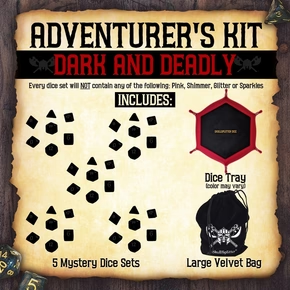Simulacrum 5e
It’s Alive! It’s ALIVE!
Simulacrum is a complicated high-level spell that creates a construct person that’s debatably alive. There’s a lot of weird applications, fringe cases, and questions people have about simulacrums and assuming your wizard gets up to casting 7th level spells it’s something you should at least consider. Get a wagonload of snow and practice your best mad scientist laugh as we go through everything you need to know.
Table of Contents:
Want to grow your dice hoard? Check out our dice subscription!
The Spell Itself
Before we dig into the specifics, let’s take a look at the raw spell itself:
Simulacrum
7th-level illusion
Casting Time: 12 hours
Range: Touch
Components: V, S, M (snow or ice in quantities sufficient to make a life-size copy of the duplicated creature; some hair, fingernail clippings, or other piece of that creature's body placed inside the snow or ice; and powdered ruby worth 1,500 gp, sprinkled over the duplicate and consumed by the spell)
Duration: Until Dispelled
You shape an illusory duplicate of one beast or humanoid that is within range for the entire casting time of the spell. The duplicate is a creature, partially real and formed from ice or snow, and it can take actions and otherwise be affected as a normal creature. It appears to be the same as the original, but it has half the creature's hit point maximum and is formed without any equipment. Otherwise, the illusion uses all the statistics of the creature it duplicates, except that it is a construct.
The simulacrum is friendly to you and creatures you designate. It obeys your spoken commands, moving and acting in accordance with your wishes and acting on your turn in combat. The simulacrum lacks the ability to learn or become more powerful, so it never increases its level or other abilities, nor can it regain expended spell slots.
If the simulacrum is damaged, you can repair it in an alchemical laboratory, using rare herbs and minerals worth 100 gp per hit point it regains. The simulacrum lasts until it drops to 0 hit points, at which point it reverts to snow and melts instantly.
If you cast this spell again, any duplicate you created with this spell is instantly destroyed.
Who Can Cast Simulacrum?
VERY few people can cast simulacrum and it is unique to the wizard class at a very high caster level. Specifically, it is a 7th-level wizard spell, meaning that you’ll need to be a minimum of a 13th level wizard before casting simulacrum.
How Does Simulacrum Work?
The simulacrum spell often gets numbered among the poorly-written spells and that’s mainly due to the plethora of questions it doesn’t answer. What it’s meant to do is give a high level wizard the ability to “build their own follower”. What it gets most often used for is breaking the game. So, when we ask how it works let’s start by asking how it’s meant to work.
To cast the simulacrum spell, you’re going to need 4 things:
- A humanoid or beast creature you want to duplicate. It has to have one of those creature types, so you can't clone like a pit fiend or a dragon. It either needs to be cool with the idea or sufficiently restrained that it can’t do anything for 12 hours.
- A bunch of ice or snow. This may either be irrelevant or a pain depending on your DM, so I’ll go into a whole section about this ice requirement in a bit.
- 1,500 gp worth of powdered rubies. This is the one “real” cost for the spell and acts as a limiter against crazy shenanigans. Making a simulacrum requires a substantial (well not insignificant anyway) amount of cash.
- 12 hours of free time. Shouldn’t be a problem, but simulacrum is definitely NOT a combat spell and it’s something you’ll be doing in the safety of downtime.
The end result is your brand-new simulacrum, an artificial being of debatable sentience and personhood that will follow your every command. They have all the abilities (including class features) of the original creature, have half as many hit points, are a construct creature, can’t learn (so no gaining class levels) and don’t regain spent spell slots if they have any. Otherwise, you have a fully identical clone of whatever critter you started with that will obey your orders, it can walk and talk and presumably has the same personality.
This creature you made comes out nude without any equipment, so you’ll have to give them clothes and weapons and whatnot for whatever you intend the simulacrum to do.
If you ever try to cast it again, the previous one poofs into snow, so you’re limited to a single simulacrum (more on ways to break past this in a bit).
The final fly in the ointment is that you can’t heal your simulacrum normally. There has been a lot of debate about this online, but it seems that the extremely expensive (100 gp per hit point) “alchemical repairs” are the only way to heal hit points off a simulacrum. This basically means you’ll have to keep your simulacrum out of combat unless you’re cool with them basically being a one-time use thing.
What’s the Deal with the Snow?
So, part of the material component costs of simulacrum is that they’re made from ice and snow. There’s no gold cost associated with this snow component, so you should technically be able to forego it using a spell focus or pouch. The rub here is that it’s a lot of snow and depending on how persnickety your dungeon master is they may decide not to handwave it away. Technically, you need an amount of ice and snow equal in size to the creature you’re duplicating since you’re essentially carving the double out of snow to start with.
So, the first and obvious way to get it is to go where there’s snow. There’s plenty of environments with plentiful snow just sitting around where anyone could scoop it up and imbue it with horrifying sentience.
If for whatever reason that’s not an option, you've got wizard spells and thankfully can just cast spells to make a bunch of ice. The 1st level wizard spell frost fingers out of the Icewind dale adventure path blasts a short cone with damaging cold magic but also conveniently freezes non-magical liquids in the area solid. Bam, attack roll that water more ice than you should need so long as you have access to a river, stream, or heck, a bathtub. The water won't even get a saving throw.
In a similar fashion, you could also use the cantrip shape water which has the option of freezing water solid. The issue here is that the spell specifies that the water melts after an hour, so unless your DM allows you to refreeze it while casting simulacrum, you’ll likely need a helper to cast it for you.
Simulacrum FAQ
It really feels like that spell description needed like another couple paragraphs of text explaining a TON of weird questions. Instead, we had to scour the internet for creator comments to answer some of your burning simulacrum questions:
Is a Simulacrum Alive?
The short answer appears to be yes! Even though it's an "illusion" the spell creates a copy of the creature with all their features and even their memories and personality intact, save that they are compelled to obey the commands of the caster. This presents some really weird moral gray areas but unless your DM specifies otherwise it appears that rules as written a simulacrum may be an illusion, but they are also a living breathing creature just as alive as the rest of us.
Does a Simulacrum Have a Soul?
This most often comes up in the context of the magic jar spell which involves transferring your soul into an object. It’s also a REALLY WEIRD MORAL GRAY AREA since it would sort of imply that casting the Simulacrum spell causes an immortal soul to come into existence. However, rules as written I can’t find a single reason why it wouldn’t have a soul. The spell says it’s an exact copy except for a few very specific exceptions, none of which mentions a soul. Most DM’s though will squinch at the aforementioned moral gray area and will typically say the simulacrum is a soulless being.
Rules as Written: Has a soul.
DM Discretion: Usually doesn’t have a soul.
How Autonomous is a Simulacrum?
Very. The simulacrum will unquestioningly follow your orders, but beyond that it has all the ability, capabilities, and mannerisms of whatever you copied. This means you can order the simulacrum to do a task that takes literal years or decades, and they'll simply keep at it until the task is done. Active duplicates still need to eat/sleep/breathe if the original did, and they can take care of themselves while carrying out your orders. So generally, a simulacrum is exactly as autonomous as the creature you copied.
Can I Make a Simulacrum of Myself?
You sure can! And that’s where things can get especially weird since as a wizard able to cast the simulacrum spell, your simulacrum will also be a wizard able to cast the simulacrum spell. We’ll go into this more in a bit, but you can absolutely make a simulacrum of yourself.
What About Sorcery Points or Other Recharging Class Abilities?
This gets tricky, because with the rules as written, any creature is capable of resting and the spell says nothing about recharging special abilities. The sorcery points class feature gets special mention here because sorcerers can use them to regain spent spell slots (blatantly bypassing the inbuilt restriction of the spell). By the RAW, this works perfectly, and you should be able to recharge anything that isn't specifically a spell slot.
However, we know from questions answered by the writer that the intended rules were that any recharging abilities didn't recharge for simulacrum. This means that the intent would technically be a house rule and the writers just screwed up.
It'll be up to your DM how they want to rule it, rules as written, or rules as intended.
Simulacrum Strategies
As with most “creative” spells, there’s a LOT of potential uses and abuses of the simulacrum spell. You may come up with something even more useful but here are some of the established applications:
Disposable Soldier
It’s a bit morbid and expensive, but if you know a huge boss fight is coming up, the simulacrum spell lets you create a duplicate creature copy of yourself or one of your allies that can throw themselves at the enemy. This isn’t a great strategy for regular adventuring, since repairing the simulacrum is incredibly expensive. But if you only plan on using them once, 1,500 gp plus the cost of equipment for essentially half of another player character at your current level is a steal. Pick the strongest member of your party and hit the xerox button.
Build-a-Servant
Considering how alive they are this is also a bit problematic but using the simulacrum spell to create an utterly loyal servant is actually one of the more common uses. It’s more useful in campaigns with strongholds or other bases of operation, but your simulacrum can loyally run your lab/base/evil lair just as well as you would with all your faculties and expertise.
Perfect Spies
Say you happen to “acquire” a cultist or agent of some shadowy organization and you need to learn more about their evil plans. If you create a simulacrum of them, you now have a perfect double agent who is utterly loyal to you with all that cultist’s memories and skills. You can start by ordering them to tell you everything they know about said shadowy organization, and then you can send them in to take the agent’s place. There’s no limit to how long your simulacrum sleeper agent can remain infiltrating them from the inside and a simulacrum is virtually indistinguishable from the real thing, even by magic.
Clone Army.
To do this correctly you need to be all the way at the top as a 20th level wizard, and you need to be this high level for the strangest reason. Specifically, you gain a 2nd, 7th-level spell slot at 20th level. This is important because it means if you create a simulacrum of yourself, your simulacrum will have a single 7th level spell slot remaining…
Let me go through the steps:
You as a 20th level wizard cast the spell simulacrum to create a double of yourself.
You hand your new double some new clothes, a fresh spellbook (cheap enough) and equip them as you see fit.
Your double has a 7th level spell slot and can also cast simulacrum on you to create yet another copy of yourself as the original caster.
This new copy also still has a 7th level spell slot, and can cast simulacrum on you…
Repeat infinite times until you daisy chain together your infinite-simulacra chain.
The limiting factors here are now the material components of 1,500 gp worth of powdered rubies, and of course access to ice or snow.
But that’s not a terribly high cost for a 20th level character, and you can easily have dozens, or even hundreds of copies of yourself through this chain cloning.
Alternately, you can also accomplish this trick as a 17th level wizard by using a 9th level spell slot to cast the wish spell. Wish is an iconic spell that lets you duplicate the effect of any lower-level spell (and a ton of other options but that's the one we care about right now). If you use your single 9th-level slot to cast wish and duplicate the effects of the simulacrum spell, that still leaves you and your new copy with a 7th level slot to create the loop.
Ok, now what?
To start with you have now officially destroyed the action economy. With one original spell you now have an army of 20th level clones each with their own turn, action, bonus action, and reaction, just like a normal character. They can attack a monster, use a magic item, or do anything else you didn't want to spend your action economy on. But they're not quite as perfect as the original.
Each member of your evil archmage clone army will only ever have the spell slots they were “born with”, so while you can certainly nova out a fireball from a hundred wizards (dear god) you can’t do it forever.
What your copies can do forever is cast cantrips, and they’ll all be considered 20th level wizards still just like you, so all those copies will be casting ray of frost or firebolt at their maximum levels. Imagine 20 of you strolling into a dungeon and in unison casting 20 max level firebolts for a quick and easy 80d10 worth of fire damage!
The main problem with this strategy is that you how have a vassal chain of command due to all this daisy chain casting. Your chain of duplicates are all under their creators control, not yours but by the simulacrum that created them. You're not in direct control of an army of clones and are rather playing a telephone game with potentially infinite 20th level wizard slaves. The chain of simulacra ultimately leads back up to you, but that chain of command becomes an unmanageable chain once you lose a single copy. If wizard A commands wizard B, and wizard B dies, then every single wizard after B (possibly C through Z or however many you've made) essentially becomes "free". And since you are a smart wizard, your copies will likely use this newfound freedom to run off to do their own thing and essentially the DMs control.
The solution to this takes a lot of work but can technically be done without any extra spellcasting. Basically, you can order your first simulacrum to order the next simulacrum to follow your orders unquestioningly. The chain of command will still be there underlying these orders in case any of them go rogue but going through this can save you from playing the telephone game.
Other Blog Posts You Might Like:
Want a character that makes magic items? Check out our Artificer 5e Guide!
Want to know how D&D dice work? Check out our DnD Dice Explained Guide!
Ever want to play a flying space monkey? Check out our Hadozee 5e guide!
Want to wield two swords like Drizzt? Check out our Two Weapon Fighting 5e Guide!

Disclaimer
Last updated: January 27, 2019
The information contained on www.SkullSplitterDice.com website (the "Service") is for general information purposes only.
www.SkullSplitterDice.com is a participant in the Amazon Services LLC Associates Program, an affiliate advertising program designed to provide a means for sites to earn advertising fees by advertising and linking to Amazon.com. (source: Section 5)
Blueshift Nine, LLC assumes no responsibility for errors or omissions in the contents on the Service.
In no event shall Blueshift Nine, LLC be liable for any special, direct, indirect, consequential, or incidental damages or any damages whatsoever, whether in an action of contract, negligence or other tort, arising out of or in connection with the use of the Service or the contents of the Service. Blueshift Nine, LLC reserves the right to make additions, deletions, or modification to the contents on the Service at any time without prior notice.
Blueshift Nine, LLC does not warrant that the Service is free of viruses or other harmful components.
Affiliate disclaimer
This affiliate disclosure details the affiliate relationships of Blueshift Nine, LLC with other companies and products.
Some of the links are "affiliate links", a link with a special tracking code. This means if you click on an affiliate link and purchase the item, we will receive an affiliate commission.
The price of the item is the same whether it is an affiliate link or not. Regardless, we only recommend products or services we believe will add value to our readers.
By using the affiliate links, you are helping support the Service, and we genuinely appreciate your support.
Affiliate advertising programs that the Service uses are:
- Amazon Services LLC Associates Program
- As an Amazon Associate, I earn from qualifying purchases.
- Blueshift Nine, LLC is a participant in the Amazon Services LLC Associates Program, an affiliate advertising program designed to provide a means for sites to earn advertising fees by advertising and linking to Amazon.com or endless.com, MYHABIT.com, SmallParts.com, or AmazonWireless.com.
- Pages on this Service may include affiliate links to Amazon and its affiliate sites on which the owner of this Service, Blueshift Nine, LLC, will make a referral commission.



